Estimating the Consumer Preferences Towards The Cane-Jaggery in Visakhapatnam District of Andhra Pradesh
0 Views
Y. SRI LAKSHMI*, I.V.Y. RAMA RAO, H. SRINIVASA RAO AND SK. NAFEEZ UMAR
Institute of Agri-Business Management, S.V. Agricultural College, ANGRAU, Tirupati-517 502.
ABSTRACT
The jaggery industry is an unorganized sector in Andhra Pradesh; and providing employment to three lakh people. The present study was taken-up to estimate the consumer preferences towards various forms of cane jaggery. An exploratory research design with multi-stage sampling technique was adopted. Andhra Pradesh state was selected purposively. Based on highest production criteria, Visakhapatnam district was selected. For respondents, 10 retail outlets were selected randomly from 10 retail outlets based on spatial variations, making-up total sample as 100. Data pertaining to 2023 year was obtained through the survey with the help of pre structured and pre-tested schedule. To draw meaningful conclusions from collected data, descriptive statistics and percentage analysis were used. Demographic characters reveal that the majority of the sample consumers were male (52%). The other major characteristics of respondents were; age group of 36 to 50 years, having under graduation degree, professionally employed, monthly income above ₹ 5,00,000, reside in urban areas and belonged to nuclear families. Majority (61%) of consumers preferred the brown color of jaggery. Both solid and granular forms were preferred by most consumers (34%) and offline retail stores were the preferred source of purchase (65%). Special occasions were the preferred time for consuming cane jaggery (56%). For sweetener purpose, majority (47%) of the consumers are preferring combination of less jaggery & more sugar.
KEYWORDS: Can-Jaggery, Consumer Buying Behaviour, Visakhapatnam, Solid form, Liquid form and Grannular form.
INTRODUCTION
Sugarcane is one of the most significant commercial crops cultivated in world. In terms of output, it is the largest crop in the world. During 2021–22, India ranked second with an output of 430.50 million tonnes from an area of 5.09 million ha and a productivity of 84.44 t/ ha (https://sugarcane.dac.gov.in). In India, sugarcane is used to manufacture sugar and jaggery, which is utilised as a sweetener in the population’s daily diet (Cooperative Sugar, 2022). India is so gradually becoming the world’s largest producer of sugar and jaggery. In India, Uttar Pradesh (UP) is the largest producer of sugarcane, followed by Maharashtra, Karnataka, Tamil Nadu, Gujarat, Haryana, Bihar and Andhra Pradesh. In Andhra Pradesh, 17% of total sugarcane cropped area is being located in Visakhapatnam district, followed by Chittoor and West Godavari. Sugarcane has mainly three processed products viz., Sugar, jaggery and Khandsari. The reason for not much preferring jaggery over sugar in earlier days is due to its non-attractive colour, lack of knowledge on medicinal properties of jaggery on part of the consumers, lesser accessibility compared to sugar, unhygienic preparation, less shelf life and easy handling of sugar in comparison to jaggery etc (Alamelu & Subramaniam, 2018). Several strategic measures have been taken up during last decade by few of the farmers by producing different forms of jaggery and making them available to the public in different forms viz., solid jaggery (blocks, cubes, balls), liquid jaggery (syrup), granular jaggery (pellets and granules) and powdered jaggery. Understanding about consumer preferences towards different forms of cane jaggery is need of the hour. Hence, present study was taken-up with following objectives.
- To elicit the demographic characters of the consumers
- To estimate consumer preference towards various forms of cane jaggery
MATERIAL AND METHODS
An exploratory research design was adopted to explore the buying behaviour of consumers towards various forms of cane jaggery. The study was conducted in Visakhapatnam district of Andhra Pradesh state. Visakhapatnam district is selected as the district occupies first place in production of cane jaggery in Andhra Pradesh. For respondents, 10 retail outlets were selected randomly from different places in Visakhapatnam based on spatial variations. From each outlet, 10 respondents were randomly selected and a total of 100 respondents were interviewed. Data pertaining to the year 2023 was obtained through the survey method and inquiries made with the help of pre-tested schedules. Primary data regarding socio-economic characteristics like household size, age, income, gender, occupation, education and purchase behaviour were collected by personally interviewing the respondents using a schedule which was pre-tested and redefined. The collected data has been analyzed by employing descriptive and percentage analysis to draw meaningful conclusions.
RESULTS AND DISCUSSIONS
A) Demographic characteristics of the consumers
A perusal of Table 1, reveals that, based on age criteria, majority (44%) of the consumers were in the age group of 36-50 years, followed by between 25-35 years (27%) and above 50 years (16%) and less than 25years (13%). Sample constitute of 52 per cent of males and 48 per cent of females.
Majority (64%) were under graduates followed by intermediate (14%), up to high school (9%), post graduates (4%) and illiterates (9%). Among the respondents, 76% were urbanites and 24% were ruralites. Based on occupational criteria, majority (57%) were into professional job followed by Agriculture (23%), housewives (11%) and 9 per cent were into business.
Regarding income levels, nearly half (49%) of the consumers had an income above ₹ 5,00,000, followed by 36% with incomes ranging from ₹ 2,00,000 to ₹ 5,00,000, 11% with incomes from ₹ 1,00,000 to ₹ 2,00,000, and 4% with incomes from ₹ 50,000 to ₹ 1,00,000.
In terms of family size, 79 per cent of consumers had four family members, up to three family members (9%), five family members (9%), and more than five members (3%).
Regarding family type, the majority (97%) of consumers belonged to nuclear families, while three per cent were from joint families. These findings are in similar with results obtained by Krishna and Balasubramanian (2018); and Vanathi and Sivakumar (2019).
B) Consumer Preferences towards various forms of cane jaggery
-
Consumer preference towards cane jaggery
The information regarding the consumer preferences towards forms of cane jaggery revealed that majority (34%) of the consumers are preferring both solid and granular forms followed by only granular form
Table 1. Socio-economic characteristics of the consumers (n = 100)
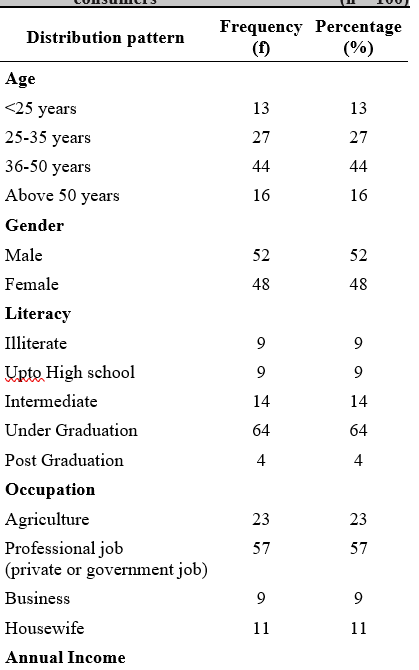
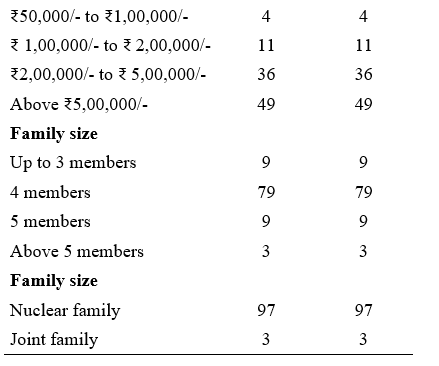
Table 2. Consumers preferences towards forms of cane jaggery (n = 100)
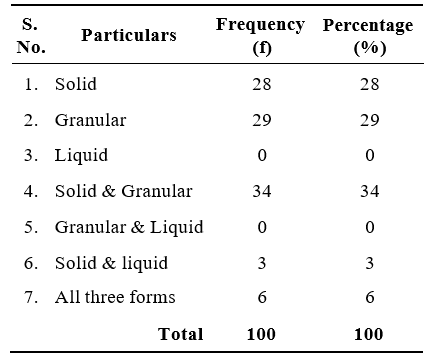
(29%), only solid form (28%), three per cent of them are preferring both solid and liquid forms but none were preferring only liquid form, while six per cent of them preferring all the three forms.
ii) Colour preference of cane jaggery by the consumers (n = 100)
It can be observed from the Table 3, majority (61%) of the consumers preferring brown colour followed by dark brown colour (27%), golden yellow colour (8%) and light yellow colour (4%). These findings of the present study are similar with the studies of Ugale et al (2019).
Table 3. Colour preference of cane jaggery by the consumers (n = 100)
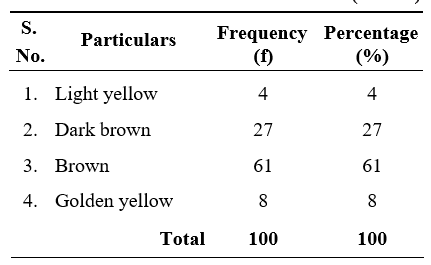
iii) Quantity preference of cane jaggery by the consumers (per month)
The information regarding quantity preference of cane jaggery by the consumers was collected and the results are depicted in the Table 4. Majority (56%) of
Table 4. Quantity preference of cane Jaggery by the consumers (n = 100)
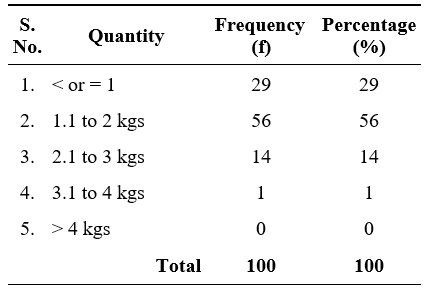
the consumers are preferring 1.1 to 2 kgs of cane jaggery followed by less than or equal to 1kg (29%), 2.1 to 3 kgs (14%) and 3.1 to 4kgs (1%).
iv) Preferred sources to purchase
The information regarding the source of purchase forms of cane jaggery by consumers were collected under four categories viz., online, offline (retailers), offline (direct from wholesalers) and others (online & offline etc). Majority (65%) of the consumers preferring to purchase cane jaggery from offline (retail stores) followed by both online & offline (24%) and 11 per cent of them are preferring to purchase directly from wholesalers.
v) Preferred time for consuming forms of cane jaggery
A perusal of Table 6 indicates that, majority (56%) of the respondents preferred time for consuming cane jaggery is on special occasions followed by random consumption (33%) and daily consumption (11%). These
Table 5. Preferred sources to purchase forms of cane jaggery (n = 100)
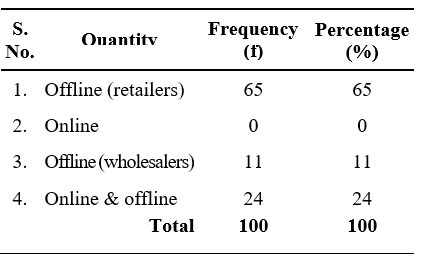
Table 6. Preferred time for consuming forms of cane jaggery

findings of the present study are similar to the studies of
Ugale et al. (2019).
vi) Preferred sweetener for consumption:
The information regarding the sweetener preferred by the consumers were collected under five categories viz., Only sugar, only jaggery, combination of more jaggery less sugar, combination of less jaggery more sugar and others (artificial sweeteners). Majority (47%) of the consumers are preferring combination of less jaggery & more sugar followed by combination of more jaggery & less sugar (29%), only jaggery (15%), only sugar (9%) (Table 7).
The major conclusions arrived through this study are listed below:
- Demographic characters reveals that the majority of the sample consumers were male (52%) and fell in the age group of 36 to 50 years (44%). Most of them had under graduation degrees (64%) and were professional employees (57%). A significant proportion of consumers (49%) had a monthly income above ₹5,00,000, and the majority resided in urban areas (76%) and belonged to nuclear families (97%).
- Consumer preferences towards various forms of cane jaggery reveals that the majority of consumers preferred the brown color of jaggery (61%). Both solid and granular forms were preferred by most consumers (34%), and offline retail stores were the preferred source of purchase (65%). Special occasions were the preferred time for consuming cane jaggery (56%). A significant portion of consumers (47%) preferred a combination of less jaggery and more sugar as a sweetener.
Table 7. Preferred sweetener for consumption (n = 100)
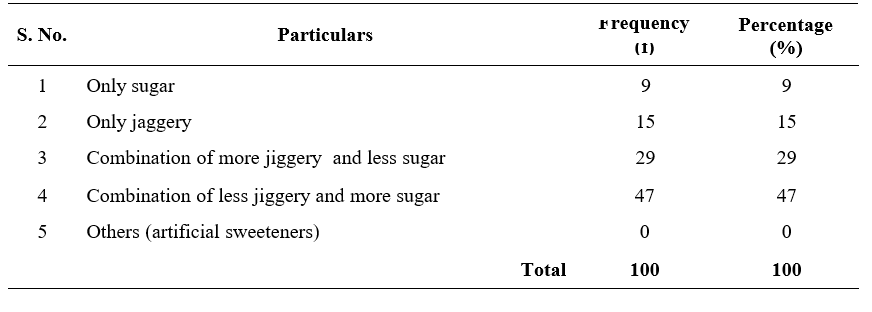
LITERATURE CITED
Alamelu, M.P and Subramaniam, K. 2018. The Role of Jaggery in Modern Consumer Food Habit. International Journal of Advanced Scientific Research and Management. 3(8).
Sugar statistics, Cooperative Sugar. 2022. 54(9): 59-61. Krishna, R and Balasubramanian, P. 2018. The significance of factors influencing consumer behaviour towards organic food products in Kochi. International Journal of Pure and Applied Mathematics. 119(12): 2641-2665.
Vanathi, S and Sivakumar, S. 2019. A study on rural and urban consumer buying behaviour towards food products of farmer producer organizations. International Journal of Agricultural Science and Research. 9(4): 53-59.
Ugale, V.G., Wandhekar, S.S., Ware, M.N and Gaikwad, S.T. 2019. Assessment of consumer preferences of Puran Poli with special focus on age and family type. Assessment. 5(4).
- Genetic Divergence Studies for Yield and Its Component Traits in Groundnut (Arachis Hypogaea L.)
- Correlation and Path Coefficient Analysis Among Early Clones Of Sugarcane (Saccharum Spp.)
- Character Association and Path Coefficient Analysis in Tomato (Solanum Lycopersicum L.)
- Survey on the Incidence of Sesame Leafhopper and Phyllody in Major Growing Districts of Southern Zone of Andhra Pradesh, India
- Effect of Organic Manures, Chemical and Biofertilizers on Potassium Use Efficiency in Groundnut
- A Study on Growth Pattern of Red Chilli in India and Andhra Pradesh

